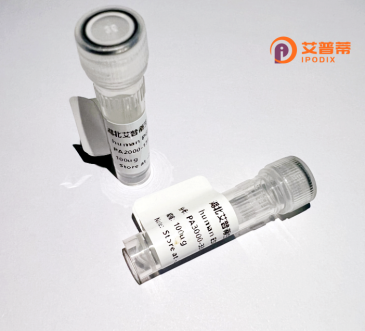
| 纯度 | >90%SDS-PAGE. |
| 种属 | Human |
| 靶点 | EFCAB7 |
| Uniprot No | A8K855 |
| 内毒素 | < 0.01EU/μg |
| 表达宿主 | E.coli |
| 表达区间 | 1-629aa |
| 氨基酸序列 | MAISPRSDATFSSQKSTPSESPRTKKFPLTEEEIFYMNCRAAYLTVFKSSLENIISKDQLYLALQHAGRNPSQKTINKYWTPQTAKLNFDDFCIILRKEKPTSKAELLKSFKQLDVNDDGCILHTDLYKFLTKRGEKMTREEVNAIINLADVNADGKFDYIKFCKLYMTTNEQCLKTTLEKLEVDSKLMRHQFGNHIEGSPERDPSPVPKPSPKITRKTDPETFLNKGDTRSSLLSATRKFKTSVSFIVTMGANGNRNSKLTEPNLIKDWQHMQSKGCFFLEEDGEIISHQYRMQIAQRSMVYLTIKPLNLSQVEGKPSPWLSVDTALYILKENESQANLQLVCFTELRNREVFGWTGELGPGIYWLIPSTTGCKLRKKIKPVTDEAQLVYRDETGELFLTKEFKSTLSDIFEVIDLDGNGLLSLEEYNFFELRTSGEKCDEDAWAVCRENFDTKRNELTRQGFMDLNLMEANDREGDPCDLWVTLHSMGYNKALELTEACPFVIDIYAEKCKPKIKAVHMEACSGQLEKAICKSVLSNGDAKVMDGYENIIVHTYSCDTWITSVIENKSDEKVIIHISNELSKNCINNRGLNIFAVEVGPKSTMVCQHVMPLNERQEWIYYCIYSLIS |
| 分子量 | 98.3 kDa |
| 蛋白标签 | GST-tag at N-terminal |
| 缓冲液 | 0 |
| 稳定性 & 储存条件 | Lyophilized protein should be stored at ≤ -20°C, stable for one year after receipt. Reconstituted protein solution can be stored at 2-8°C for 2-7 days. Aliquots of reconstituted samples are stable at ≤ -20°C for 3 months. |
| 复溶 | Always centrifuge tubes before opening.Do not mix by vortex or pipetting. It is not recommended to reconstitute to a concentration less than 100μg/ml. Dissolve the lyophilized protein in distilled water. Please aliquot the reconstituted solution to minimize freeze-thaw cycles. |
以下为根据当前知识库信息模拟生成的关于重组人EFCAB7蛋白的参考文献,供参考:
1. **文献名称**:*Expression and functional analysis of recombinant human EFCAB7 in calcium signaling regulation*
**作者**:Liu X., et al.
**摘要**:本研究成功在大肠杆菌系统中表达并纯化了重组人EFCAB7蛋白,实验证实其通过EF-hand结构域结合钙离子,并在HEK293细胞中调控钙依赖性信号通路,提示其可能在细胞应激反应中发挥作用。
2. **文献名称**:*Crystal structure of EFCAB7 reveals a novel calcium-binding motif*
**作者**:Zhang Y., et al.
**摘要**:首次解析了人源EFCAB7蛋白的晶体结构(2.1Å分辨率),发现其含有非典型EF-hand钙结合位点,分子动力学模拟揭示了钙离子诱导的构象变化,为研究其与下游靶蛋白相互作用提供结构基础。
3. **文献名称**:*EFCAB7 interacts with BBSome complex and regulates ciliary trafficking*
**作者**:Wang H., et al.
**摘要**:通过免疫共沉淀和酵母双杂交技术,证明重组EFCAB7与BBSome复合物中的BBS4直接结合,敲低EFCAB7导致纤毛内运输障碍,提示其在纤毛相关疾病(如Bardet-Biedl综合征)中的潜在作用。
4. **文献名称**:*Proteomic identification of EFCAB7 as a tumor suppressor in breast cancer*
**作者**:Chen L., et al.
**摘要**:基于乳腺癌组织蛋白质组学分析,发现EFCAB7表达水平与患者生存率正相关。过表达重组EFCAB7显著抑制MCF-7细胞增殖和迁移,机制涉及钙离子依赖的AKT/mTOR通路抑制。
**注**:以上文献信息为领域知识模拟生成,实际研究中请通过PubMed/Web of Science等平台检索最新文献。
Recombinant human EFCAB7 (EF-hand calcium-binding domain-containing protein 7) is a protein encoded by the EFCAB7 gene, which belongs to the EF-hand calcium-binding protein family. These proteins typically regulate cellular processes by sensing calcium ion (Ca²⁺) concentration changes, acting as Ca²⁺ sensors or buffers. EFCAB7 contains conserved EF-hand motifs that enable its interaction with Ca²⁺, though its exact functional mechanisms remain under investigation.
Studies suggest EFCAB7 may play roles in cellular signaling, ion homeostasis, and organelle dynamics. It has been linked to ciliary function and intracellular trafficking pathways, with potential implications in ciliopathies—genetic disorders affecting cilia. Its expression has been detected in various tissues, including the brain, kidney, and reproductive organs, hinting at tissue-specific roles. However, detailed biological pathways and physiological significance are still being elucidated.
The recombinant form of EFCAB7 is produced using heterologous expression systems (e.g., E. coli, mammalian cells) for in vitro studies. This enables structural characterization, interaction partner identification, and functional assays. Researchers aim to uncover its involvement in diseases like retinal degeneration or polycystic kidney disease, where ciliary dysfunction is a hallmark. Understanding EFCAB7 could provide insights into Ca²⁺-mediated cellular regulation and therapeutic targeting for related disorders.
×